Wireless Network Security: Threats, Countermeasures, and Analysis
VerifiedAdded on 2020/03/23
|11
|2339
|60
Report
AI Summary
This report provides a comprehensive overview of threats to wireless networks and their corresponding countermeasures. It begins by introducing the benefits of wireless networking and the associated security risks. The report then details various types of wireless network attacks, including accidental and malicious associations, non-traditional network vulnerabilities, denial-of-service attacks, network injection, and MAC spoofing. For each threat, the report outlines potential countermeasures, such as securing wireless access points and client devices, using encryption, implementing anti-spyware and firewalls, turning off identifier broadcasting, changing default router settings, and training users. The report emphasizes the importance of regular network auditing and concludes that while complete elimination of threats is impossible, effective countermeasures and a proactive approach to risk management are essential for maintaining a secure wireless network. The report also highlights the significance of user training and education as key components of wireless network security.
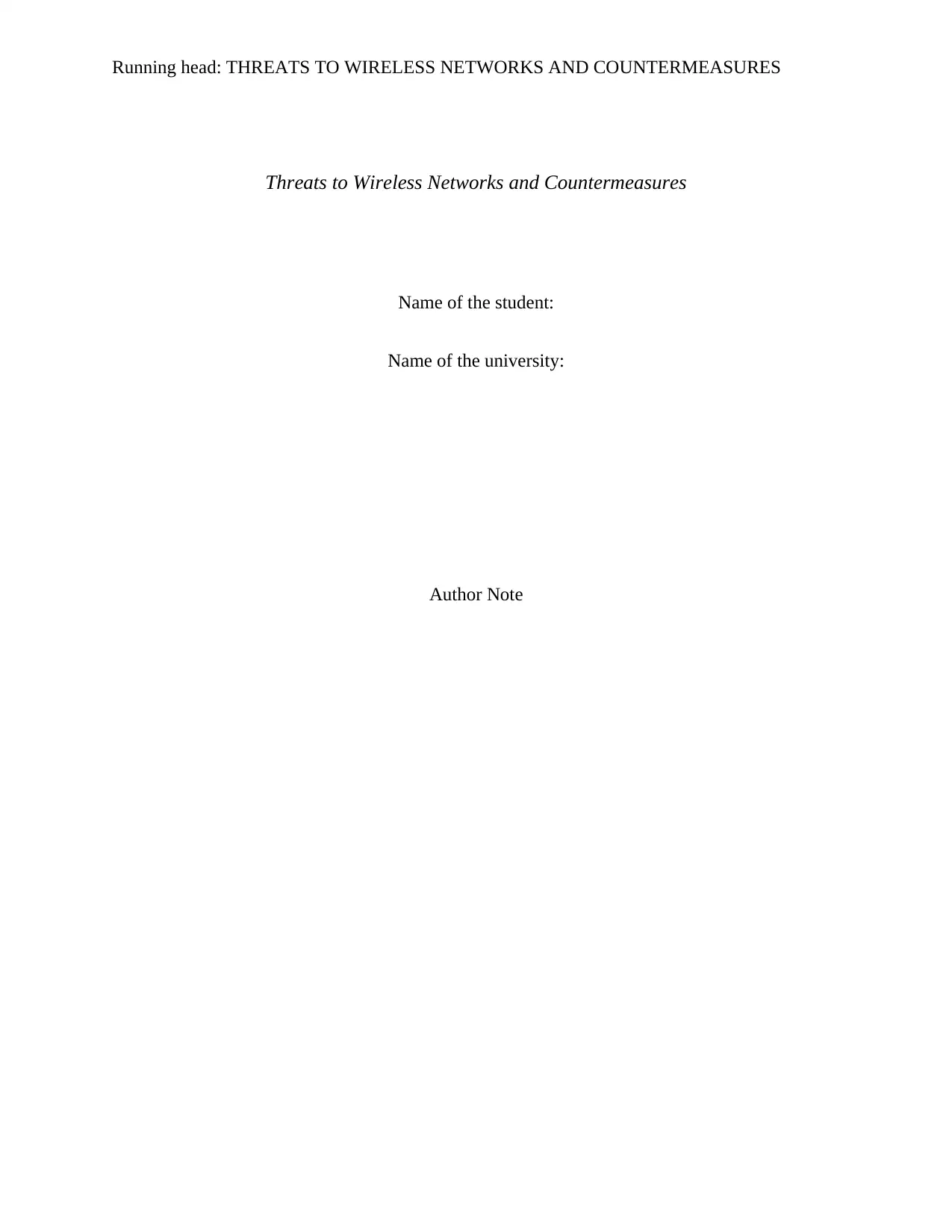
Running head: THREATS TO WIRELESS NETWORKS AND COUNTERMEASURES
Threats to Wireless Networks and Countermeasures
Name of the student:
Name of the university:
Author Note
Threats to Wireless Networks and Countermeasures
Name of the student:
Name of the university:
Author Note
Paraphrase This Document
Need a fresh take? Get an instant paraphrase of this document with our AI Paraphraser
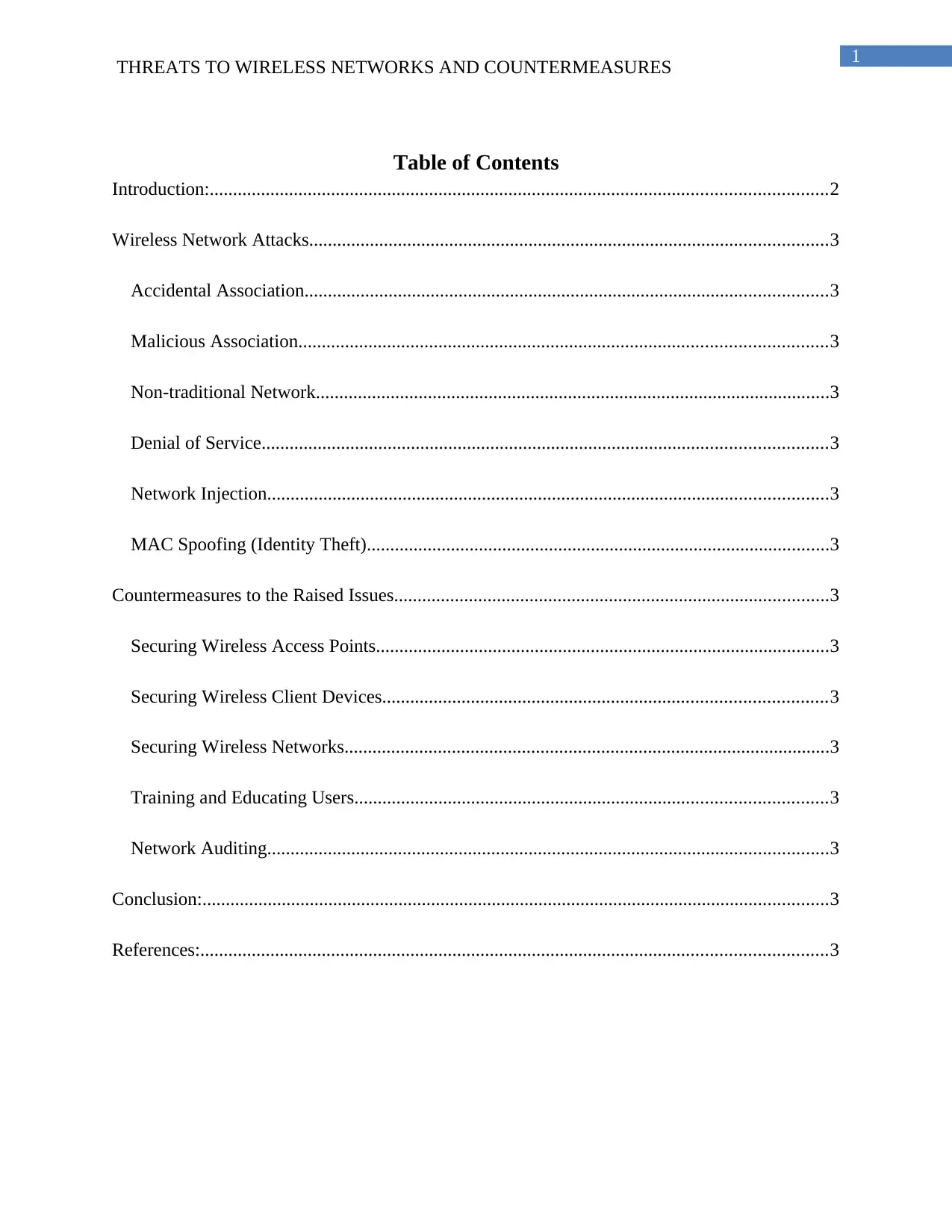
1
THREATS TO WIRELESS NETWORKS AND COUNTERMEASURES
Table of Contents
Introduction:....................................................................................................................................2
Wireless Network Attacks...............................................................................................................3
Accidental Association................................................................................................................3
Malicious Association.................................................................................................................3
Non-traditional Network..............................................................................................................3
Denial of Service.........................................................................................................................3
Network Injection........................................................................................................................3
MAC Spoofing (Identity Theft)...................................................................................................3
Countermeasures to the Raised Issues.............................................................................................3
Securing Wireless Access Points.................................................................................................3
Securing Wireless Client Devices...............................................................................................3
Securing Wireless Networks........................................................................................................3
Training and Educating Users.....................................................................................................3
Network Auditing........................................................................................................................3
Conclusion:......................................................................................................................................3
References:......................................................................................................................................3
THREATS TO WIRELESS NETWORKS AND COUNTERMEASURES
Table of Contents
Introduction:....................................................................................................................................2
Wireless Network Attacks...............................................................................................................3
Accidental Association................................................................................................................3
Malicious Association.................................................................................................................3
Non-traditional Network..............................................................................................................3
Denial of Service.........................................................................................................................3
Network Injection........................................................................................................................3
MAC Spoofing (Identity Theft)...................................................................................................3
Countermeasures to the Raised Issues.............................................................................................3
Securing Wireless Access Points.................................................................................................3
Securing Wireless Client Devices...............................................................................................3
Securing Wireless Networks........................................................................................................3
Training and Educating Users.....................................................................................................3
Network Auditing........................................................................................................................3
Conclusion:......................................................................................................................................3
References:......................................................................................................................................3
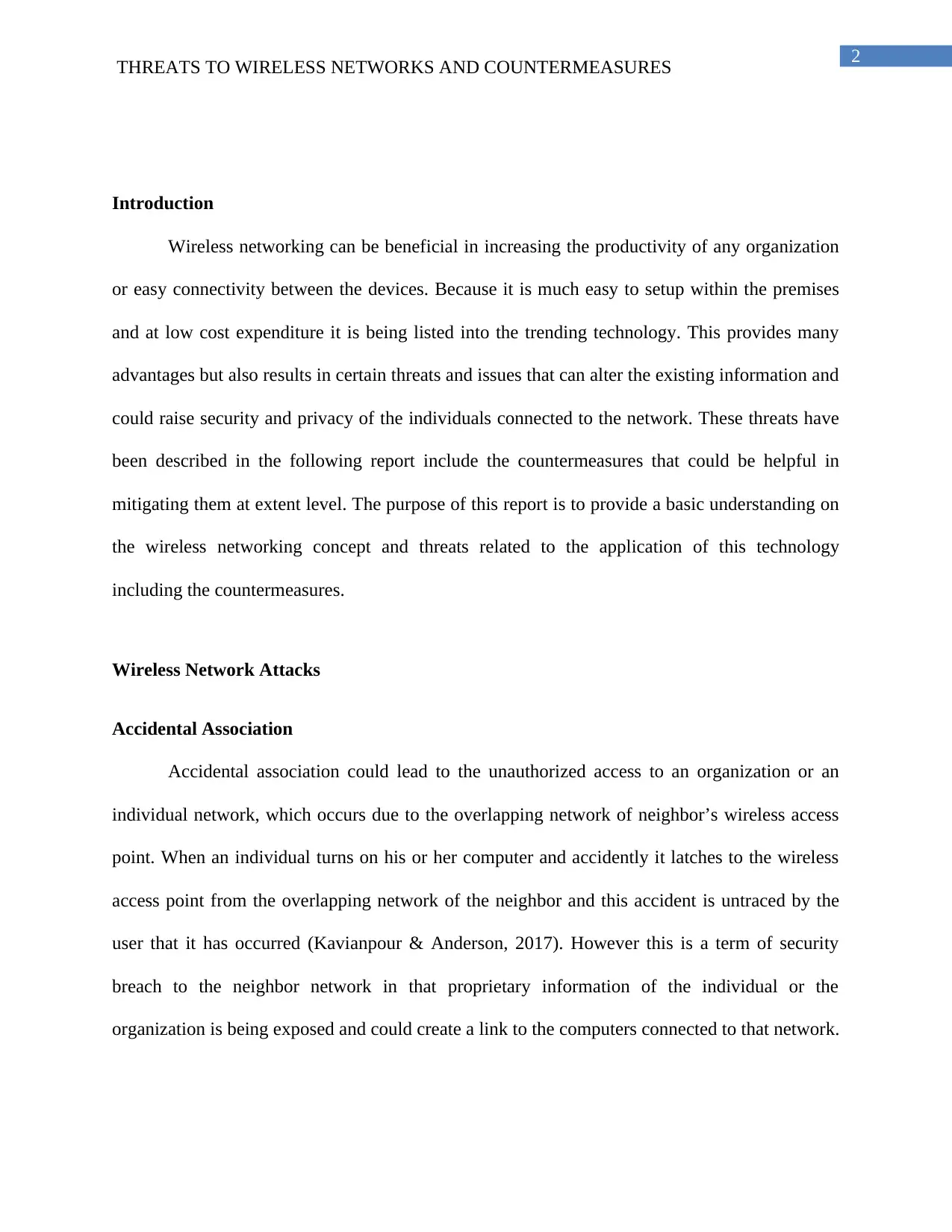
2
THREATS TO WIRELESS NETWORKS AND COUNTERMEASURES
Introduction
Wireless networking can be beneficial in increasing the productivity of any organization
or easy connectivity between the devices. Because it is much easy to setup within the premises
and at low cost expenditure it is being listed into the trending technology. This provides many
advantages but also results in certain threats and issues that can alter the existing information and
could raise security and privacy of the individuals connected to the network. These threats have
been described in the following report include the countermeasures that could be helpful in
mitigating them at extent level. The purpose of this report is to provide a basic understanding on
the wireless networking concept and threats related to the application of this technology
including the countermeasures.
Wireless Network Attacks
Accidental Association
Accidental association could lead to the unauthorized access to an organization or an
individual network, which occurs due to the overlapping network of neighbor’s wireless access
point. When an individual turns on his or her computer and accidently it latches to the wireless
access point from the overlapping network of the neighbor and this accident is untraced by the
user that it has occurred (Kavianpour & Anderson, 2017). However this is a term of security
breach to the neighbor network in that proprietary information of the individual or the
organization is being exposed and could create a link to the computers connected to that network.
THREATS TO WIRELESS NETWORKS AND COUNTERMEASURES
Introduction
Wireless networking can be beneficial in increasing the productivity of any organization
or easy connectivity between the devices. Because it is much easy to setup within the premises
and at low cost expenditure it is being listed into the trending technology. This provides many
advantages but also results in certain threats and issues that can alter the existing information and
could raise security and privacy of the individuals connected to the network. These threats have
been described in the following report include the countermeasures that could be helpful in
mitigating them at extent level. The purpose of this report is to provide a basic understanding on
the wireless networking concept and threats related to the application of this technology
including the countermeasures.
Wireless Network Attacks
Accidental Association
Accidental association could lead to the unauthorized access to an organization or an
individual network, which occurs due to the overlapping network of neighbor’s wireless access
point. When an individual turns on his or her computer and accidently it latches to the wireless
access point from the overlapping network of the neighbor and this accident is untraced by the
user that it has occurred (Kavianpour & Anderson, 2017). However this is a term of security
breach to the neighbor network in that proprietary information of the individual or the
organization is being exposed and could create a link to the computers connected to that network.
⊘ This is a preview!⊘
Do you want full access?
Subscribe today to unlock all pages.

Trusted by 1+ million students worldwide
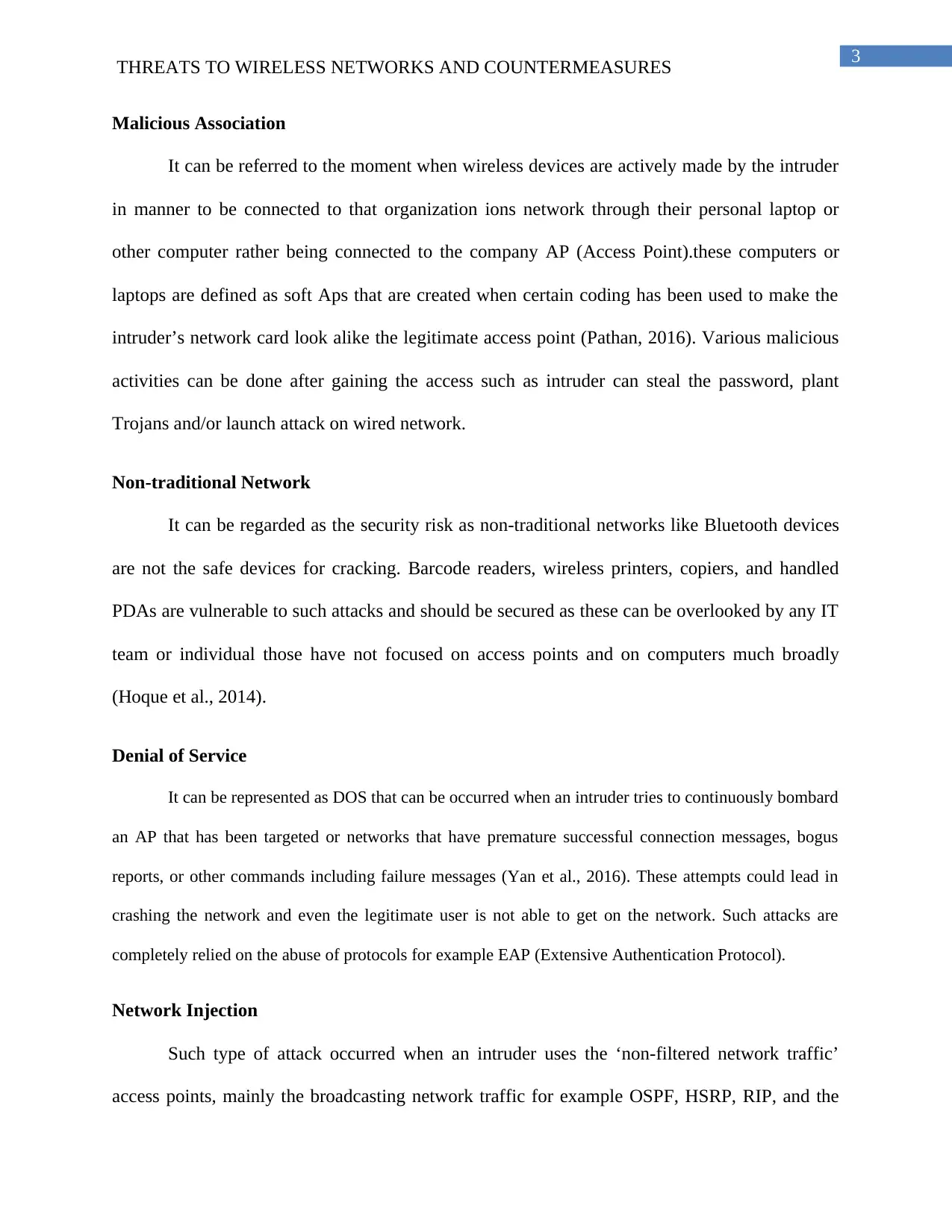
3
THREATS TO WIRELESS NETWORKS AND COUNTERMEASURES
Malicious Association
It can be referred to the moment when wireless devices are actively made by the intruder
in manner to be connected to that organization ions network through their personal laptop or
other computer rather being connected to the company AP (Access Point).these computers or
laptops are defined as soft Aps that are created when certain coding has been used to make the
intruder’s network card look alike the legitimate access point (Pathan, 2016). Various malicious
activities can be done after gaining the access such as intruder can steal the password, plant
Trojans and/or launch attack on wired network.
Non-traditional Network
It can be regarded as the security risk as non-traditional networks like Bluetooth devices
are not the safe devices for cracking. Barcode readers, wireless printers, copiers, and handled
PDAs are vulnerable to such attacks and should be secured as these can be overlooked by any IT
team or individual those have not focused on access points and on computers much broadly
(Hoque et al., 2014).
Denial of Service
It can be represented as DOS that can be occurred when an intruder tries to continuously bombard
an AP that has been targeted or networks that have premature successful connection messages, bogus
reports, or other commands including failure messages (Yan et al., 2016). These attempts could lead in
crashing the network and even the legitimate user is not able to get on the network. Such attacks are
completely relied on the abuse of protocols for example EAP (Extensive Authentication Protocol).
Network Injection
Such type of attack occurred when an intruder uses the ‘non-filtered network traffic’
access points, mainly the broadcasting network traffic for example OSPF, HSRP, RIP, and the
THREATS TO WIRELESS NETWORKS AND COUNTERMEASURES
Malicious Association
It can be referred to the moment when wireless devices are actively made by the intruder
in manner to be connected to that organization ions network through their personal laptop or
other computer rather being connected to the company AP (Access Point).these computers or
laptops are defined as soft Aps that are created when certain coding has been used to make the
intruder’s network card look alike the legitimate access point (Pathan, 2016). Various malicious
activities can be done after gaining the access such as intruder can steal the password, plant
Trojans and/or launch attack on wired network.
Non-traditional Network
It can be regarded as the security risk as non-traditional networks like Bluetooth devices
are not the safe devices for cracking. Barcode readers, wireless printers, copiers, and handled
PDAs are vulnerable to such attacks and should be secured as these can be overlooked by any IT
team or individual those have not focused on access points and on computers much broadly
(Hoque et al., 2014).
Denial of Service
It can be represented as DOS that can be occurred when an intruder tries to continuously bombard
an AP that has been targeted or networks that have premature successful connection messages, bogus
reports, or other commands including failure messages (Yan et al., 2016). These attempts could lead in
crashing the network and even the legitimate user is not able to get on the network. Such attacks are
completely relied on the abuse of protocols for example EAP (Extensive Authentication Protocol).
Network Injection
Such type of attack occurred when an intruder uses the ‘non-filtered network traffic’
access points, mainly the broadcasting network traffic for example OSPF, HSRP, RIP, and the
Paraphrase This Document
Need a fresh take? Get an instant paraphrase of this document with our AI Paraphraser
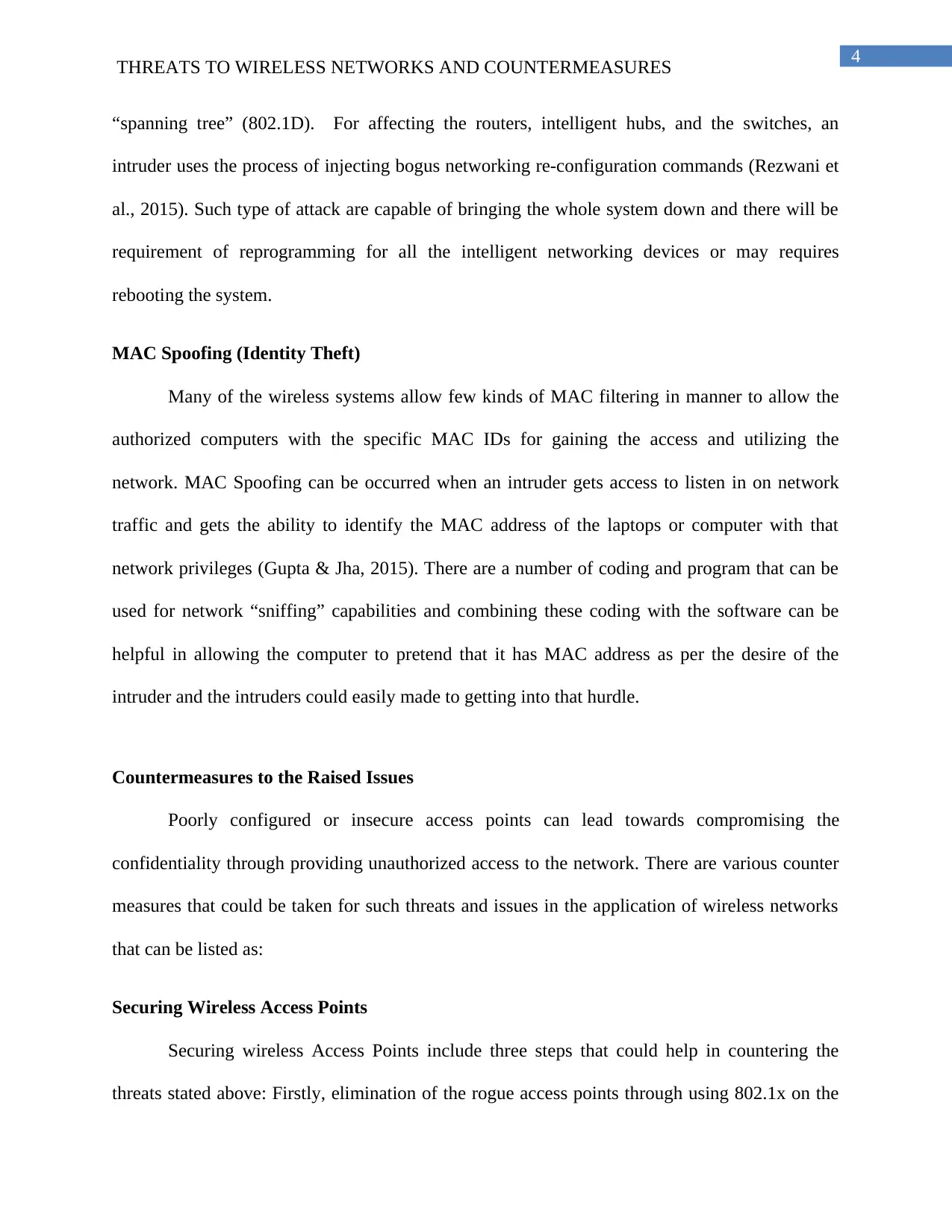
4
THREATS TO WIRELESS NETWORKS AND COUNTERMEASURES
“spanning tree” (802.1D). For affecting the routers, intelligent hubs, and the switches, an
intruder uses the process of injecting bogus networking re-configuration commands (Rezwani et
al., 2015). Such type of attack are capable of bringing the whole system down and there will be
requirement of reprogramming for all the intelligent networking devices or may requires
rebooting the system.
MAC Spoofing (Identity Theft)
Many of the wireless systems allow few kinds of MAC filtering in manner to allow the
authorized computers with the specific MAC IDs for gaining the access and utilizing the
network. MAC Spoofing can be occurred when an intruder gets access to listen in on network
traffic and gets the ability to identify the MAC address of the laptops or computer with that
network privileges (Gupta & Jha, 2015). There are a number of coding and program that can be
used for network “sniffing” capabilities and combining these coding with the software can be
helpful in allowing the computer to pretend that it has MAC address as per the desire of the
intruder and the intruders could easily made to getting into that hurdle.
Countermeasures to the Raised Issues
Poorly configured or insecure access points can lead towards compromising the
confidentiality through providing unauthorized access to the network. There are various counter
measures that could be taken for such threats and issues in the application of wireless networks
that can be listed as:
Securing Wireless Access Points
Securing wireless Access Points include three steps that could help in countering the
threats stated above: Firstly, elimination of the rogue access points through using 802.1x on the
THREATS TO WIRELESS NETWORKS AND COUNTERMEASURES
“spanning tree” (802.1D). For affecting the routers, intelligent hubs, and the switches, an
intruder uses the process of injecting bogus networking re-configuration commands (Rezwani et
al., 2015). Such type of attack are capable of bringing the whole system down and there will be
requirement of reprogramming for all the intelligent networking devices or may requires
rebooting the system.
MAC Spoofing (Identity Theft)
Many of the wireless systems allow few kinds of MAC filtering in manner to allow the
authorized computers with the specific MAC IDs for gaining the access and utilizing the
network. MAC Spoofing can be occurred when an intruder gets access to listen in on network
traffic and gets the ability to identify the MAC address of the laptops or computer with that
network privileges (Gupta & Jha, 2015). There are a number of coding and program that can be
used for network “sniffing” capabilities and combining these coding with the software can be
helpful in allowing the computer to pretend that it has MAC address as per the desire of the
intruder and the intruders could easily made to getting into that hurdle.
Countermeasures to the Raised Issues
Poorly configured or insecure access points can lead towards compromising the
confidentiality through providing unauthorized access to the network. There are various counter
measures that could be taken for such threats and issues in the application of wireless networks
that can be listed as:
Securing Wireless Access Points
Securing wireless Access Points include three steps that could help in countering the
threats stated above: Firstly, elimination of the rogue access points through using 802.1x on the
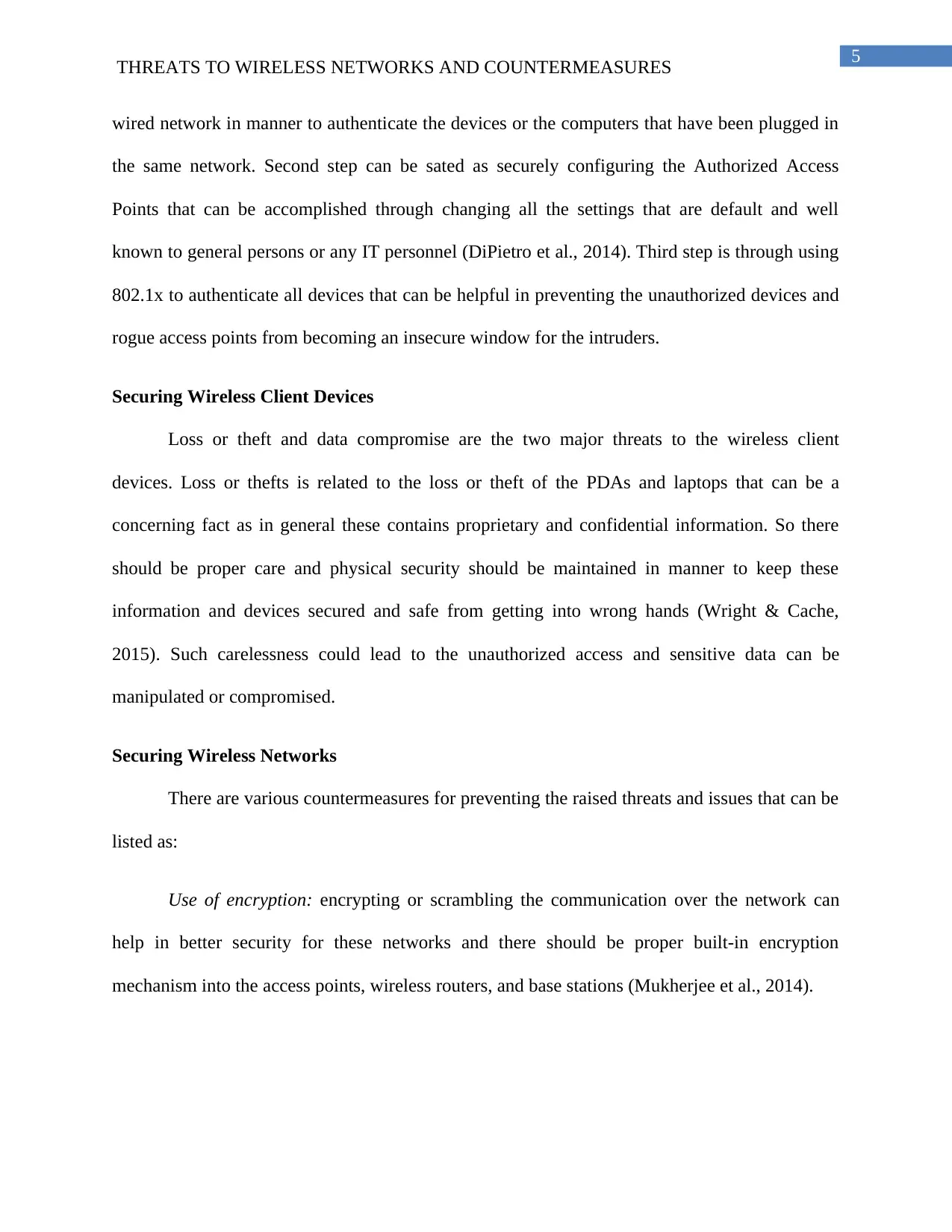
5
THREATS TO WIRELESS NETWORKS AND COUNTERMEASURES
wired network in manner to authenticate the devices or the computers that have been plugged in
the same network. Second step can be sated as securely configuring the Authorized Access
Points that can be accomplished through changing all the settings that are default and well
known to general persons or any IT personnel (DiPietro et al., 2014). Third step is through using
802.1x to authenticate all devices that can be helpful in preventing the unauthorized devices and
rogue access points from becoming an insecure window for the intruders.
Securing Wireless Client Devices
Loss or theft and data compromise are the two major threats to the wireless client
devices. Loss or thefts is related to the loss or theft of the PDAs and laptops that can be a
concerning fact as in general these contains proprietary and confidential information. So there
should be proper care and physical security should be maintained in manner to keep these
information and devices secured and safe from getting into wrong hands (Wright & Cache,
2015). Such carelessness could lead to the unauthorized access and sensitive data can be
manipulated or compromised.
Securing Wireless Networks
There are various countermeasures for preventing the raised threats and issues that can be
listed as:
Use of encryption: encrypting or scrambling the communication over the network can
help in better security for these networks and there should be proper built-in encryption
mechanism into the access points, wireless routers, and base stations (Mukherjee et al., 2014).
THREATS TO WIRELESS NETWORKS AND COUNTERMEASURES
wired network in manner to authenticate the devices or the computers that have been plugged in
the same network. Second step can be sated as securely configuring the Authorized Access
Points that can be accomplished through changing all the settings that are default and well
known to general persons or any IT personnel (DiPietro et al., 2014). Third step is through using
802.1x to authenticate all devices that can be helpful in preventing the unauthorized devices and
rogue access points from becoming an insecure window for the intruders.
Securing Wireless Client Devices
Loss or theft and data compromise are the two major threats to the wireless client
devices. Loss or thefts is related to the loss or theft of the PDAs and laptops that can be a
concerning fact as in general these contains proprietary and confidential information. So there
should be proper care and physical security should be maintained in manner to keep these
information and devices secured and safe from getting into wrong hands (Wright & Cache,
2015). Such carelessness could lead to the unauthorized access and sensitive data can be
manipulated or compromised.
Securing Wireless Networks
There are various countermeasures for preventing the raised threats and issues that can be
listed as:
Use of encryption: encrypting or scrambling the communication over the network can
help in better security for these networks and there should be proper built-in encryption
mechanism into the access points, wireless routers, and base stations (Mukherjee et al., 2014).
⊘ This is a preview!⊘
Do you want full access?
Subscribe today to unlock all pages.

Trusted by 1+ million students worldwide
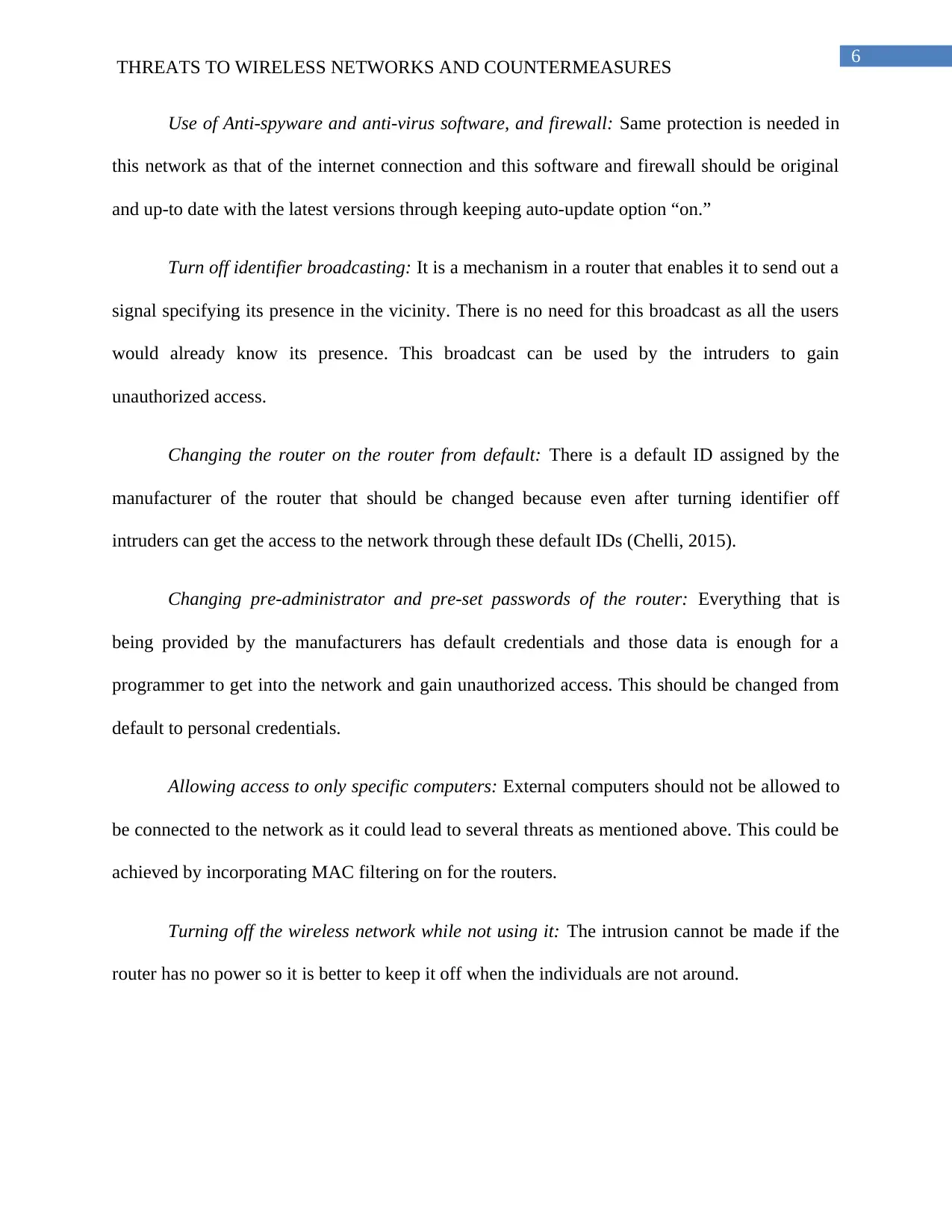
6
THREATS TO WIRELESS NETWORKS AND COUNTERMEASURES
Use of Anti-spyware and anti-virus software, and firewall: Same protection is needed in
this network as that of the internet connection and this software and firewall should be original
and up-to date with the latest versions through keeping auto-update option “on.”
Turn off identifier broadcasting: It is a mechanism in a router that enables it to send out a
signal specifying its presence in the vicinity. There is no need for this broadcast as all the users
would already know its presence. This broadcast can be used by the intruders to gain
unauthorized access.
Changing the router on the router from default: There is a default ID assigned by the
manufacturer of the router that should be changed because even after turning identifier off
intruders can get the access to the network through these default IDs (Chelli, 2015).
Changing pre-administrator and pre-set passwords of the router: Everything that is
being provided by the manufacturers has default credentials and those data is enough for a
programmer to get into the network and gain unauthorized access. This should be changed from
default to personal credentials.
Allowing access to only specific computers: External computers should not be allowed to
be connected to the network as it could lead to several threats as mentioned above. This could be
achieved by incorporating MAC filtering on for the routers.
Turning off the wireless network while not using it: The intrusion cannot be made if the
router has no power so it is better to keep it off when the individuals are not around.
THREATS TO WIRELESS NETWORKS AND COUNTERMEASURES
Use of Anti-spyware and anti-virus software, and firewall: Same protection is needed in
this network as that of the internet connection and this software and firewall should be original
and up-to date with the latest versions through keeping auto-update option “on.”
Turn off identifier broadcasting: It is a mechanism in a router that enables it to send out a
signal specifying its presence in the vicinity. There is no need for this broadcast as all the users
would already know its presence. This broadcast can be used by the intruders to gain
unauthorized access.
Changing the router on the router from default: There is a default ID assigned by the
manufacturer of the router that should be changed because even after turning identifier off
intruders can get the access to the network through these default IDs (Chelli, 2015).
Changing pre-administrator and pre-set passwords of the router: Everything that is
being provided by the manufacturers has default credentials and those data is enough for a
programmer to get into the network and gain unauthorized access. This should be changed from
default to personal credentials.
Allowing access to only specific computers: External computers should not be allowed to
be connected to the network as it could lead to several threats as mentioned above. This could be
achieved by incorporating MAC filtering on for the routers.
Turning off the wireless network while not using it: The intrusion cannot be made if the
router has no power so it is better to keep it off when the individuals are not around.
Paraphrase This Document
Need a fresh take? Get an instant paraphrase of this document with our AI Paraphraser
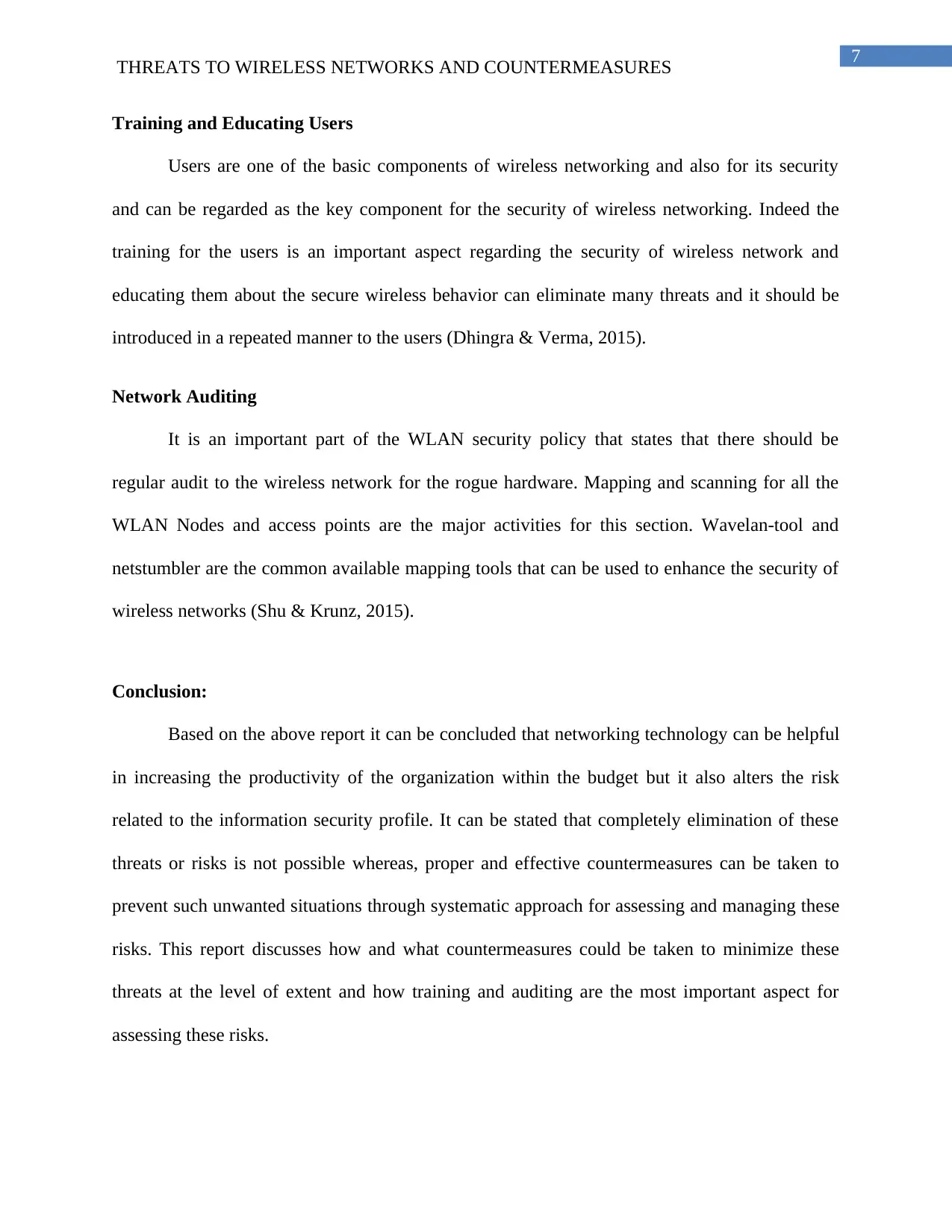
7
THREATS TO WIRELESS NETWORKS AND COUNTERMEASURES
Training and Educating Users
Users are one of the basic components of wireless networking and also for its security
and can be regarded as the key component for the security of wireless networking. Indeed the
training for the users is an important aspect regarding the security of wireless network and
educating them about the secure wireless behavior can eliminate many threats and it should be
introduced in a repeated manner to the users (Dhingra & Verma, 2015).
Network Auditing
It is an important part of the WLAN security policy that states that there should be
regular audit to the wireless network for the rogue hardware. Mapping and scanning for all the
WLAN Nodes and access points are the major activities for this section. Wavelan-tool and
netstumbler are the common available mapping tools that can be used to enhance the security of
wireless networks (Shu & Krunz, 2015).
Conclusion:
Based on the above report it can be concluded that networking technology can be helpful
in increasing the productivity of the organization within the budget but it also alters the risk
related to the information security profile. It can be stated that completely elimination of these
threats or risks is not possible whereas, proper and effective countermeasures can be taken to
prevent such unwanted situations through systematic approach for assessing and managing these
risks. This report discusses how and what countermeasures could be taken to minimize these
threats at the level of extent and how training and auditing are the most important aspect for
assessing these risks.
THREATS TO WIRELESS NETWORKS AND COUNTERMEASURES
Training and Educating Users
Users are one of the basic components of wireless networking and also for its security
and can be regarded as the key component for the security of wireless networking. Indeed the
training for the users is an important aspect regarding the security of wireless network and
educating them about the secure wireless behavior can eliminate many threats and it should be
introduced in a repeated manner to the users (Dhingra & Verma, 2015).
Network Auditing
It is an important part of the WLAN security policy that states that there should be
regular audit to the wireless network for the rogue hardware. Mapping and scanning for all the
WLAN Nodes and access points are the major activities for this section. Wavelan-tool and
netstumbler are the common available mapping tools that can be used to enhance the security of
wireless networks (Shu & Krunz, 2015).
Conclusion:
Based on the above report it can be concluded that networking technology can be helpful
in increasing the productivity of the organization within the budget but it also alters the risk
related to the information security profile. It can be stated that completely elimination of these
threats or risks is not possible whereas, proper and effective countermeasures can be taken to
prevent such unwanted situations through systematic approach for assessing and managing these
risks. This report discusses how and what countermeasures could be taken to minimize these
threats at the level of extent and how training and auditing are the most important aspect for
assessing these risks.
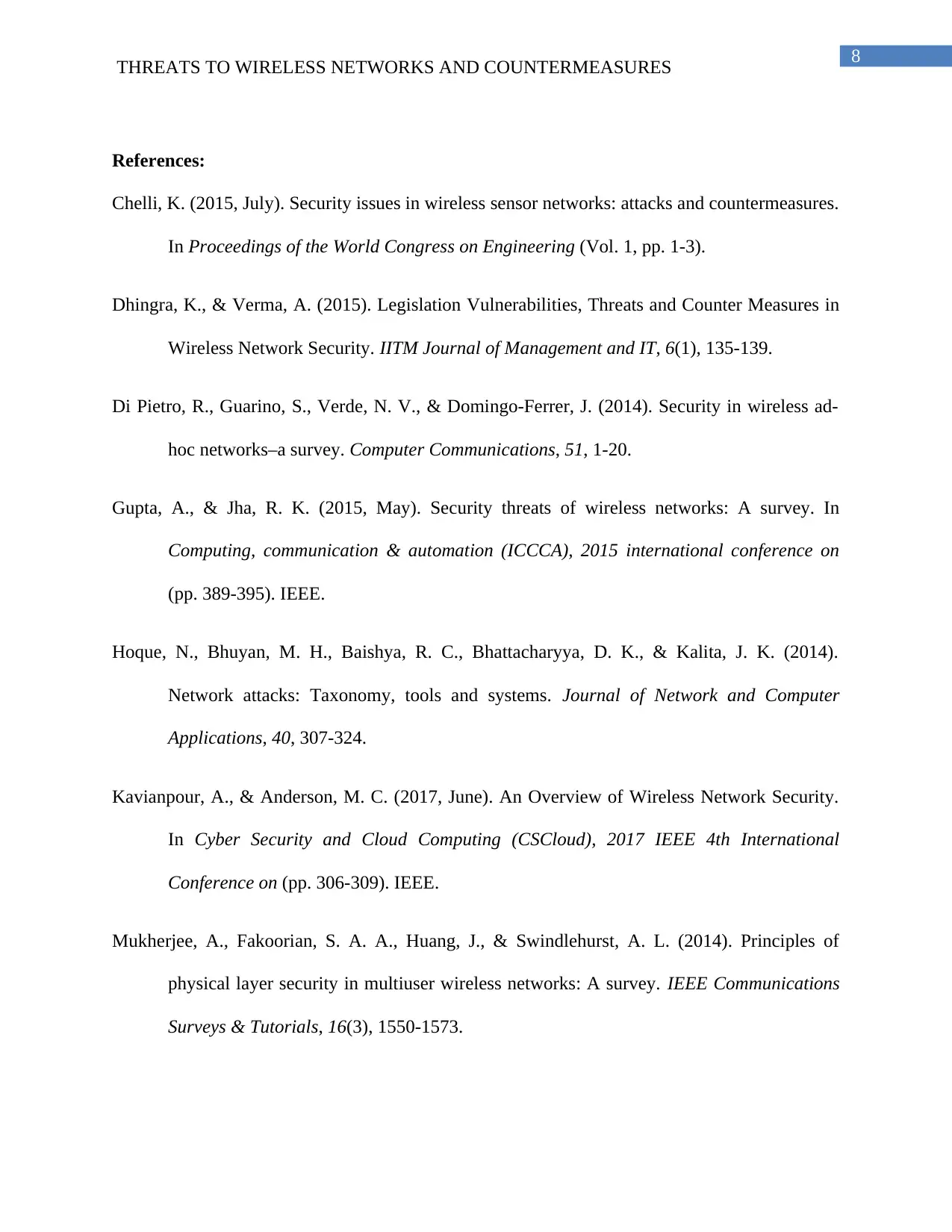
8
THREATS TO WIRELESS NETWORKS AND COUNTERMEASURES
References:
Chelli, K. (2015, July). Security issues in wireless sensor networks: attacks and countermeasures.
In Proceedings of the World Congress on Engineering (Vol. 1, pp. 1-3).
Dhingra, K., & Verma, A. (2015). Legislation Vulnerabilities, Threats and Counter Measures in
Wireless Network Security. IITM Journal of Management and IT, 6(1), 135-139.
Di Pietro, R., Guarino, S., Verde, N. V., & Domingo-Ferrer, J. (2014). Security in wireless ad-
hoc networks–a survey. Computer Communications, 51, 1-20.
Gupta, A., & Jha, R. K. (2015, May). Security threats of wireless networks: A survey. In
Computing, communication & automation (ICCCA), 2015 international conference on
(pp. 389-395). IEEE.
Hoque, N., Bhuyan, M. H., Baishya, R. C., Bhattacharyya, D. K., & Kalita, J. K. (2014).
Network attacks: Taxonomy, tools and systems. Journal of Network and Computer
Applications, 40, 307-324.
Kavianpour, A., & Anderson, M. C. (2017, June). An Overview of Wireless Network Security.
In Cyber Security and Cloud Computing (CSCloud), 2017 IEEE 4th International
Conference on (pp. 306-309). IEEE.
Mukherjee, A., Fakoorian, S. A. A., Huang, J., & Swindlehurst, A. L. (2014). Principles of
physical layer security in multiuser wireless networks: A survey. IEEE Communications
Surveys & Tutorials, 16(3), 1550-1573.
THREATS TO WIRELESS NETWORKS AND COUNTERMEASURES
References:
Chelli, K. (2015, July). Security issues in wireless sensor networks: attacks and countermeasures.
In Proceedings of the World Congress on Engineering (Vol. 1, pp. 1-3).
Dhingra, K., & Verma, A. (2015). Legislation Vulnerabilities, Threats and Counter Measures in
Wireless Network Security. IITM Journal of Management and IT, 6(1), 135-139.
Di Pietro, R., Guarino, S., Verde, N. V., & Domingo-Ferrer, J. (2014). Security in wireless ad-
hoc networks–a survey. Computer Communications, 51, 1-20.
Gupta, A., & Jha, R. K. (2015, May). Security threats of wireless networks: A survey. In
Computing, communication & automation (ICCCA), 2015 international conference on
(pp. 389-395). IEEE.
Hoque, N., Bhuyan, M. H., Baishya, R. C., Bhattacharyya, D. K., & Kalita, J. K. (2014).
Network attacks: Taxonomy, tools and systems. Journal of Network and Computer
Applications, 40, 307-324.
Kavianpour, A., & Anderson, M. C. (2017, June). An Overview of Wireless Network Security.
In Cyber Security and Cloud Computing (CSCloud), 2017 IEEE 4th International
Conference on (pp. 306-309). IEEE.
Mukherjee, A., Fakoorian, S. A. A., Huang, J., & Swindlehurst, A. L. (2014). Principles of
physical layer security in multiuser wireless networks: A survey. IEEE Communications
Surveys & Tutorials, 16(3), 1550-1573.
⊘ This is a preview!⊘
Do you want full access?
Subscribe today to unlock all pages.

Trusted by 1+ million students worldwide
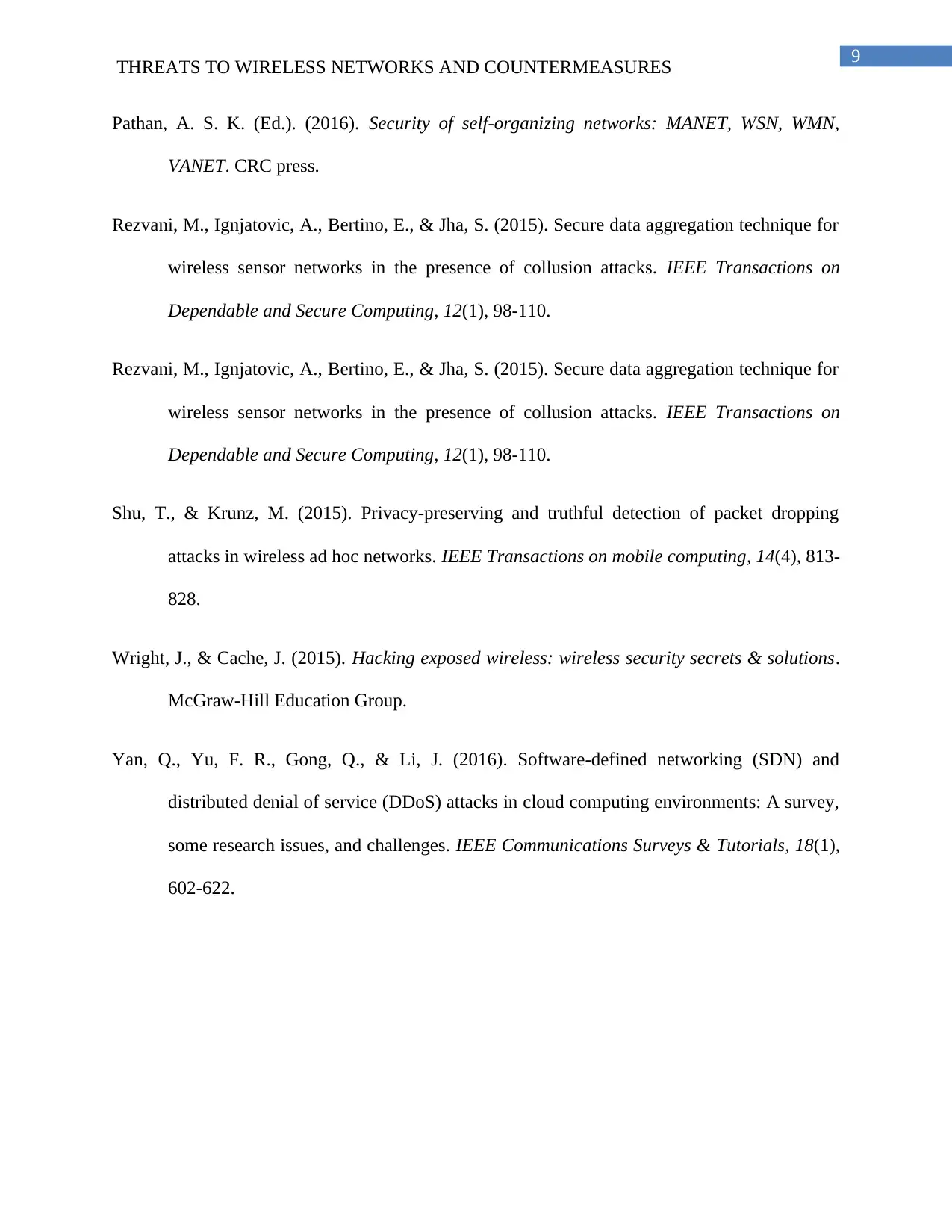
9
THREATS TO WIRELESS NETWORKS AND COUNTERMEASURES
Pathan, A. S. K. (Ed.). (2016). Security of self-organizing networks: MANET, WSN, WMN,
VANET. CRC press.
Rezvani, M., Ignjatovic, A., Bertino, E., & Jha, S. (2015). Secure data aggregation technique for
wireless sensor networks in the presence of collusion attacks. IEEE Transactions on
Dependable and Secure Computing, 12(1), 98-110.
Rezvani, M., Ignjatovic, A., Bertino, E., & Jha, S. (2015). Secure data aggregation technique for
wireless sensor networks in the presence of collusion attacks. IEEE Transactions on
Dependable and Secure Computing, 12(1), 98-110.
Shu, T., & Krunz, M. (2015). Privacy-preserving and truthful detection of packet dropping
attacks in wireless ad hoc networks. IEEE Transactions on mobile computing, 14(4), 813-
828.
Wright, J., & Cache, J. (2015). Hacking exposed wireless: wireless security secrets & solutions.
McGraw-Hill Education Group.
Yan, Q., Yu, F. R., Gong, Q., & Li, J. (2016). Software-defined networking (SDN) and
distributed denial of service (DDoS) attacks in cloud computing environments: A survey,
some research issues, and challenges. IEEE Communications Surveys & Tutorials, 18(1),
602-622.
THREATS TO WIRELESS NETWORKS AND COUNTERMEASURES
Pathan, A. S. K. (Ed.). (2016). Security of self-organizing networks: MANET, WSN, WMN,
VANET. CRC press.
Rezvani, M., Ignjatovic, A., Bertino, E., & Jha, S. (2015). Secure data aggregation technique for
wireless sensor networks in the presence of collusion attacks. IEEE Transactions on
Dependable and Secure Computing, 12(1), 98-110.
Rezvani, M., Ignjatovic, A., Bertino, E., & Jha, S. (2015). Secure data aggregation technique for
wireless sensor networks in the presence of collusion attacks. IEEE Transactions on
Dependable and Secure Computing, 12(1), 98-110.
Shu, T., & Krunz, M. (2015). Privacy-preserving and truthful detection of packet dropping
attacks in wireless ad hoc networks. IEEE Transactions on mobile computing, 14(4), 813-
828.
Wright, J., & Cache, J. (2015). Hacking exposed wireless: wireless security secrets & solutions.
McGraw-Hill Education Group.
Yan, Q., Yu, F. R., Gong, Q., & Li, J. (2016). Software-defined networking (SDN) and
distributed denial of service (DDoS) attacks in cloud computing environments: A survey,
some research issues, and challenges. IEEE Communications Surveys & Tutorials, 18(1),
602-622.
Paraphrase This Document
Need a fresh take? Get an instant paraphrase of this document with our AI Paraphraser

10
THREATS TO WIRELESS NETWORKS AND COUNTERMEASURES
THREATS TO WIRELESS NETWORKS AND COUNTERMEASURES
1 out of 11
Related Documents
Your All-in-One AI-Powered Toolkit for Academic Success.
+13062052269
info@desklib.com
Available 24*7 on WhatsApp / Email
![[object Object]](/_next/static/media/star-bottom.7253800d.svg)
Unlock your academic potential
Copyright © 2020–2025 A2Z Services. All Rights Reserved. Developed and managed by ZUCOL.





